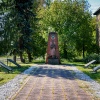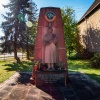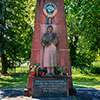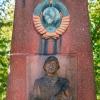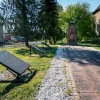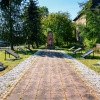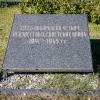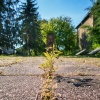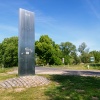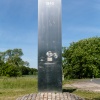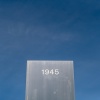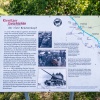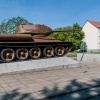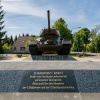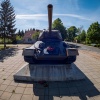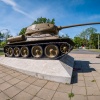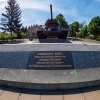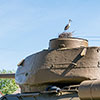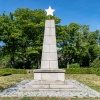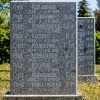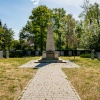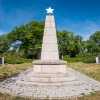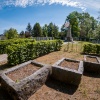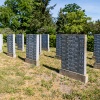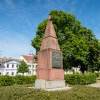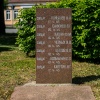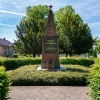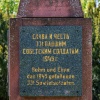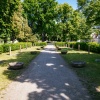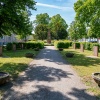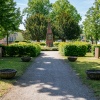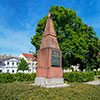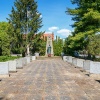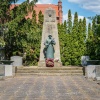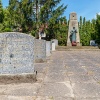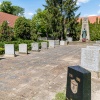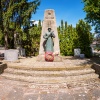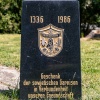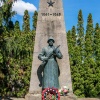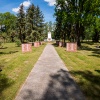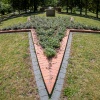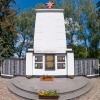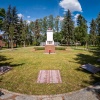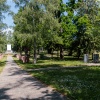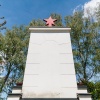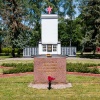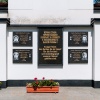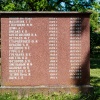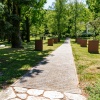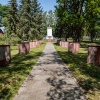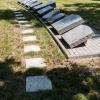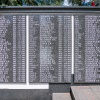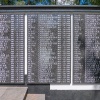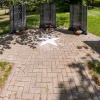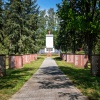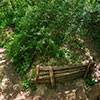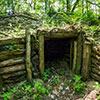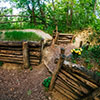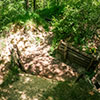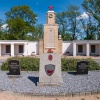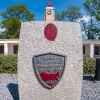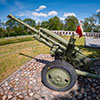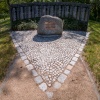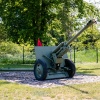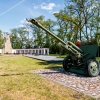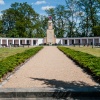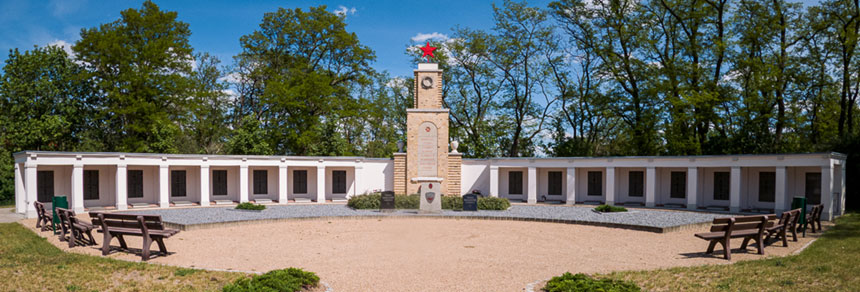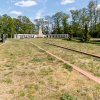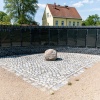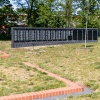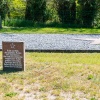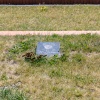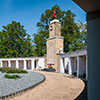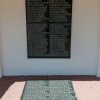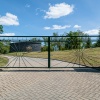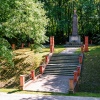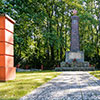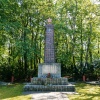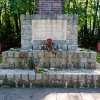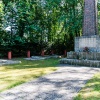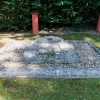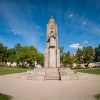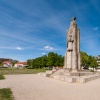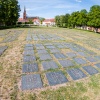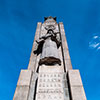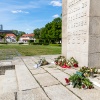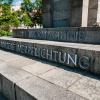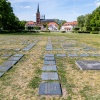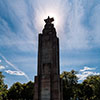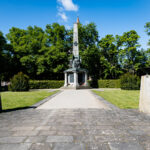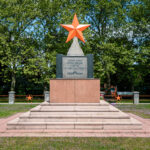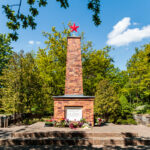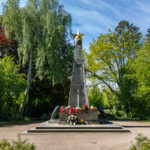75 Years – 75 Memorials – Stage 5: The Oderbruch Soviet memorials
Stage 5 of the photo project “75 years – 75 memorials” leads me to the very important Soviet memorials of Oderbruch region, where Red Army crossed Oder River for the first time back in the beginning of 1945. I start this ~90 kilometres ride in Küstrin-Kietz, cycle on the Oder dike Oderdeich to Kienitz, Groß Neuendorf and Letschin as well as Manschnow, Reitwein, Lebus and Booßen, to finish in Frankfurt (Oder).
Here is the 1st stage – 2nd stage – 3rd stage – 4th stage – 5th stage – 6th stage – 7th stage of this photo project
Soldier statues and Guard of Honour in the Oderbruch
This tour has to start early as there are more than 10 memorials to visit and almost 100 kilometres to pedal. To boot it is a public holiday and half of Berlin seeks to escape the urban environment. Hence I get up at 6 o’clock to start the one-hour trip to Küstrin-Kietz. Ostkreuz platform 7 is harder to find than some vegetation-covered Soviet memorial… Platform 7 serves the east-west direction of travel out of town and runs north parallel to lines S3, S5, etc. The 14 station journey via Strausberg and Seelow to Küstrin-Kietz is done by fellow rail colleagues of Niederbarnimer Eisenbahn.
The fifth stage of my photo project is actually the most important one, because it gives Oderbruch a visit. Here, in the Oderbruch region, the Red Army crossed the frozen Oder River for the first time on 31 January and 1 February near Kienitz and formed three bridgeheads. It’s no big surprise that the Oderbruch fights claimed a lot of victims. 4.900 are buried in Lebus, 3.000 in Reitwein, 1.200 in Manschnow and the few 372 villagers of Groß Neuendorf have 1.400 fallen Red Army soldiers in their town.
Having arrived Küstrin-Kietz, my first way leads to the local Soviet memorial right on Karl-Marx-Strasse. It depicts a granite-made Red Army soldier holding his rifle and standing wake in honour. Later on I’ll see this form of memorial more often in the Oderbruch, for example in Manschnow but also in Frankfurt (Oder). On the way to Oder River cycle path I see a “war grave site” sign and follow it. Maybe there is something interesting to see. Well, apart from a weeding grandma, whose looks at the alien cyclist are as lethal as her fingers are to the weeds, there was nothing to discover.
Heavenly cycling pleasure along Oder River dyke
I literally fly over the Oder dike cycle path, that is the main cycle path in the Oderbruch. WHAT an awesome ride…! My downhill tyre pushes like a steam locomotive and lets me develop an average speed of 29 km/h on the first 20 kilometres section to the bridgehead metal stele near Kienitz. On the way I realise what a Berlin construction worker and a stork have in common: both need their “morning sausage”. Well, for the storks definitely without beer, and an optional shot. But that’s why some 20 storks fly right above me towards Oder River meadows now, to have breakfast. What an absolutely beautiful moment!
The bridgehead monument is the Oderbruch’s youngest memorial and a premium steel stele just to the south of Kienitz. Quickly I have got all my photos in the bag and head towards the actual Kienitz village. Rushing through an approaching old-timer parade, I screw up this defile of Nazi helmet wearing and Germany flag waving Father’s Day procession. In the centre of Kienitz village is their counterpart, an excellently maintained Soviet T-34; the tank that gave the Nazis shivers. With 80.000 of this type being produced, the T-34 is the world’s most built tank.
How stupid – ok, they are Nazis – is it to develop a petrol-based tank (meaning the “famous” Panther and Tiger)? The Russian T-34 was a lot more agile, easier to build and only needed diesel. In winter a diesel engine could be started faster and Diesel itself was faster, cheaper and technically less demanding to produce than petrol. Ok, enough about tanks now… One of the famous Oderbruch storks is nesting right behind the Kienitz T-34. It extends its legs, but doesn’t really land… Damn! That means headwind :-(
The graves of the Soviet bridgehead
The stork arrives and I depart towards to Groß Neuendorf. The soviet memorial over there looks quite functional. It is a golden instead of red Soviet star could mean that here is/are (a) hero(es) of the Soviet Union buried. Unfortunately, no one has an idea about that. It is scary to see on the graves stones that one particular date marks the death of 90% of the people being buried, that is February 1st, 1945; the day of the first crossing of Oder River. Nude sunbathing mama next door feels disturbed by my photographic work. My interest in grave stones only doesn’t convince her, hence I take on the headwind bicycle challenge to Letschin.
On the way to Letschin I decide that the bloody headwind and I definitely won’t ride into the sunset together this evening. Its gusts let some 20% of pedalling efforts vanish into thin air. Fortunately, Letschin is only 8 kilometres away. The Soviet memorial over there is located on the southern old central village green. While I am taking pictures, I notice the busy traffic. It is (on this holiday!) heavier than in Berlin at my front door. Fire bowls line the way along the grave plates of the Letschin memorial and almost everywhere the last days of the Second World War are listed as the day of death.
Two thirds of the Oderbruch tour are covered
The tour continues to Manschnow, but before I cycles through Oderbruch metropolises like Zechin, Golzow and Gorgast. Having sit more than 50 kilometres in the saddle already, my butt demands a little break. Luckily, the guy next to Gabi’s hairdresser – yes, the unique hairdresser with an apostrophe in its name, that is a total grammatical failure in German – offers a fresh cool blonde draught. The local group of men strengthening themselves the Father’s Day way, is not exactly what I call friendly, so I continue my way to nearby Manschnow, where the youth club is closed but the hearts are open.
The Manschnow memorial is very picturesque and has, just like in Küstrin-Kietz and Frankfurt (Oder), a resolutely looking Red Army soldier statue and his rifle standing guard. Very interesting is the small black memorial stone being donated by a Soviet garrison. Unlike the other gravestones it celebrates the 650th anniversary of Manschnow. A Soviet garrison. Maybe there were as many soldiers being deployed and living nearby as in Vogelsang? Another interesting feature is a commemorative plaque in memory of Sergeant Titov from Sochi sitting in the nearby house wall. Unfortunately, its background remains unknown.
When I head off towards Reitwein, the local kids, perhaps because of the closed youth club, look after me as if they knew that I was drawn to Reitwein. At first glance “rite” and “wine” sounds like a correct way of growing Riesling. In fact, there is a mountain, what is very untypical for the super flat Oderbruch region, that is the Reitweiner Sporn. The Reitwein Soviet memorial lies at its feet and is just big… There are dozens of gravestones and it is final resting place for some 3.000 fallen Red Army soldiers. Four of them are heroes of the Soviet Union and are mentioned by name and appearance on the large Soviet star topped main memorial.
Cycling up the Reitweiner Sporn hill is a stinging nettle thing, but the way is worth it. From up here Georgy Konstantinovich Zhukov, the Marshal of the Soviet Union and later Minister of Defence, one of those guys being decorated with hundreds medals, observed the Battle of Oderbruch and the Battle of the Seelow Heights. The victory was his, but he also demanded the highest blood tax. All of the Oderbruch memorials also tell about this story. At Zhukov’s time the forest wasn’t as dense as today, hence nowadays sight of the Oderbruch plains is only possible during leafless winter months.
The large Lebus Soviet memorial has a special role
My Oderbruch journey continues to Lebus. The country roads give way again to the beautiful cycle path on the Oder River dyke. Of course now I meet more people than in the morning, but the tour is still great pleasure. Even the bloody headwind doesn’t bother me anymore. Unfortunately, the Anglerheim restaurant in Lebus is not open, but Oderblick further down the road offers a sausage and a beer. Woohoo! I take a longer break, because I a) made everything in a very good and b) the remaining ~20 kilometres are not a particular problem anymore.
Beside beer and bratwurst Lebus is also not unimportant from the Soviet memorials’ point of view as this little village holds nowadays most important grave site. All Soviet soldier remains being found internationally these days, get reburied to Lebus. Each year 40 to 50 soldiers are found only in the Brandenburg district. Just like Reitwein, the Lebus grave site complex is large. It is topped by an obelisk and colonnades at the eastern end. The artillery gun standing halfway between entrance and colonnades is quite an eye catcher. And as if I ordered it, a European garden redstart flies in and lands on the cannon’s flower-decorated flash damper. Maybe a higher power tries to emphasise the peace aspect of my photo series :-)
My memorial tour goes on to Booßen, a northern part of Frankfurt (Oder). My cycling trip leads me through typical Brandenburg sand roads. Yay… Fortunately the trail releases me pretty much right at the memorial site, that is located on B5 main road. Being surrounded by trees, the memorial is still in its original condition. Only the adjacent columns saw some paint in the last years. The memorial is dedicated to Red Army soldiers fallen shortly before WW2’s end.
Let’s go back home by RE1
And then the end of this more than 90 kilometres long stage comes into sight, that is Frankfurt (Oder). The former GDR district capital’s Soviet memorial is located in a park called Der Anger. The large meadow has a monument in the middle showing a Red Army soldier standing guard. He looks to the west. The grave plates of war cemetery for more than 1.400 people buried are located in the north, where the cityscape gets formed by Gertrauden Church and the Oder Tower. Well, and then it is already time to go back home by RE1 regional train.
Here is the route as well as data of this tour on Komoot
